This Is Ancient Egyptian Art Made Around the Time of the Pyramids at Giza Its Date Should Be
Art is an essential attribute of whatever civilization. In one case the bones human needs have been taken care of such as food, shelter, some class of community police, and a religious belief, cultures begin producing artwork, and frequently all of these developments occur more or less simultaneously. This process began in the Predynastic Period in Egypt (c. 6000 - c. 3150 BCE) through images of animals, human being beings, and supernatural figures inscribed on rock walls. These early images were crude in comparing to later developments merely still limited an important value of Egyptian cultural consciousness: balance.
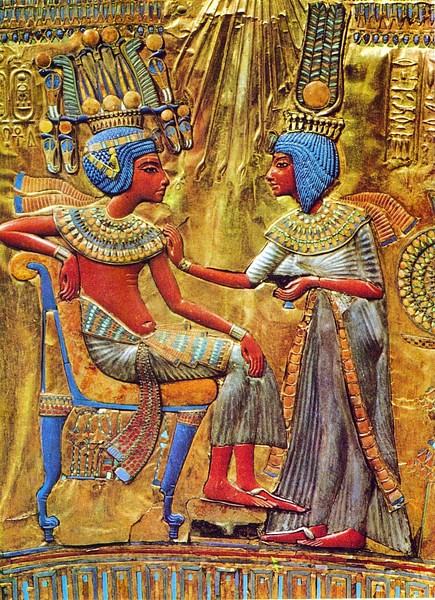
Tutankhamun & Ankhsenamun
Egyptian society was based on the concept of harmony known as ma'at which had come into being at the dawn of creation and sustained the universe. All Egyptian fine art is based on perfect rest because it reflects the ideal earth of the gods. The same way these gods provided all good gifts for humanity, so the artwork was imagined and created to provide a employ. Egyptian art was always commencement and foremost functional. No thing how beautifully a statue may take been crafted, its purpose was to serve every bit a dwelling for a spirit or a god. An amulet would have been designed to exist attractive but aesthetic beauty was non the driving force in its creation, protection was. Tomb paintings, temple tableaus, home and palace gardens all were created and so that their form suited an of import role and, in many cases, this function was a reminder of the eternal nature of life and the value of personal and communal stability.
Early Dynastic Menses Art
The value of residuum, expressed as symmetry, infused Egyptian fine art from the earliest times. The stone art from the Predynastic Period establishes this value which is fully adult and realized in the Early Dynastic Catamenia of Egypt (c. 3150 - c. 2613 BCE). Fine art from this period reaches its height in the work known every bit The Narmer Palette (c. 3200-3000 BCE) which was created to celebrate the unity of Upper and Lower Egypt nether Rex Narmer (c. 3150 BCE). Through a series of engravings on a siltstone slab, shaped as a chevron shield, the story is told of the great male monarch'south victory over his enemies and how the gods encouraged and approved his actions. Although some of the images of the palette are difficult to interpret, the story of unification and the commemoration of the rex is quite clear.
![Narmer Palette [Two Sides]](https://www.worldhistory.org/img/r/p/500x600/4412.jpg?v=1649972822)
Narmer Palette [Two Sides]
On the front end, Narmer is associated with the divine forcefulness of the bull (possibly the Apis Balderdash) and is seen wearing the crown of Upper and Lower Arab republic of egypt in a triumphal procession. Beneath him, two men wrestle with entwined beasts which are often interpreted as representing Upper and Lower Egypt (though this view is contested and in that location seems no justification for it). The reverse side shows the king'due south victory over his enemies while the gods await on approvingly. All these scenes are carved in depression-raised relief with incredible skill.
This technique would be used quite effectively toward the end of the Early on Dynastic Period by the architect Imhotep (c. 2667-2600 BCE) in designing the pyramid complex of King Djoser (c. 2670 BCE). Images of lotus flowers, papyrus plants, and the djed symbol are intricately worked into the architecture of the buildings in both high and low relief. By this time the sculptors had also mastered the art of working in stone to created 3-dimensional life-sized statues. The statue of Djoser is among the greatest works of art from this flow.
Old Kingdom Art
This skill would develop during the Sometime Kingdom of Egypt (c. 2613-2181 BCE) when a strong fundamental government and economic prosperity combined to allow for monumental works similar the Great Pyramid of Giza, the Sphinx, and elaborate tomb and temple paintings. The obelisk, first developed in the Early Dynastic Menstruum, was refined and more widely used during the Erstwhile Kingdom. Tomb paintings became increasingly sophisticated but statuary remained static for the almost part. A comparison between the statue of Djoser from Saqqara and a small-scale ivory statue of King Khufu (2589-2566 BCE) plant at Giza brandish the aforementioned form and technique. Both of these works, even so, are exceptional pieces in execution and particular.
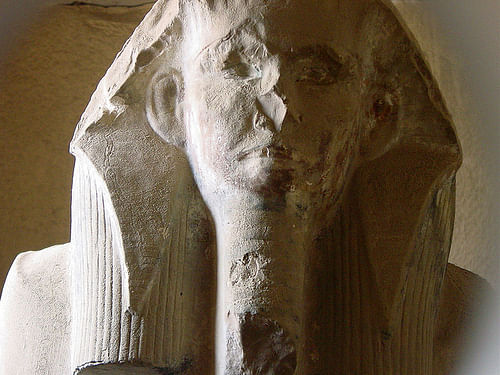
Djoser
Art during the Old Kingdom was state mandated which means the king or a high-ranking dignity commissioned a piece and too dictated its mode. This is why there is such uniformity in Old Kingdom artwork: different artists may take had their ain vision but they had to create in accordance with their client's wishes. This paradigm changed when the Old Kingdom collapsed and initiated the First Intermediate Catamenia (2181-2040 BCE).
Fine art in the First Intermediate Period
The First Intermediate Menstruation has long been characterized as a time of chaos and darkness and artwork from this era has been used to substantiate such claims. The statement from fine art rests on an interpretation of Start Intermediate Period works as poor quality equally well equally an absence of monumental building projects to prove that Egyptian culture was in a kind of gratuitous fall toward chaos and dissolution. In reality, the First Intermediate Period of Egypt was a time of tremendous growth and cultural modify. The quality of the artwork resulted from a lack of a strong central government and the corresponding absence of state-mandated art.
The quality of the artwork resulted from a lack of a strong central government & the corresponding absence of land-mandated fine art.
The different districts were now costless to develop their own vision in the arts and create according to that vision. There is nix 'depression quality' well-nigh First Intermediate Menstruum art; information technology is simply dissimilar from Former Kingdom artwork. The lack of monumental building projects during this time is also hands explained: the dynasties of the Quondam Kingdom had drained the regime treasury in creating their own grand monuments and, past the time of the 5th Dynasty, there were no resources left for such projects. The plummet of the Sometime Kingdom post-obit the 6th Dynasty certainly was a time of confusion, but at that place is no testify to suggest the era which followed was whatever kind of 'dark age'.
The Outset Intermediate Period produced a number of fine pieces but also saw the rise of mass-produced artwork. Items which had previously been made past a unmarried artist were now assembled and painted by a production crew. Amulets, coffins, ceramics, and shabti dolls were amongst these crafts. Shabti dolls were important funerary objects which were buried with the deceased and were idea to come to life in the next world and tend to i'southward responsibilities. These were made of faience, stone, or wood merely, in the First Intermediate Period, are mostly of wood and mass produced to be sold cheaply. Shabti dolls were of import items because they would allow the soul to relax in the afterlife while the shabti did one'southward work. Previously, only the wealthy could afford shabti dolls, but in this era, they were available to those of more modest means.
Middle Kingdom Art
The Kickoff Intermediate Period ended when Mentuhotep Two (c. 2061-2010 BCE) of Thebes defeated the kings of Herakleopolis and initiated the Middle Kingdom of Egypt (2040-1782 BCE). Thebes now became the capital of Egypt and a strong central government again had the power to dictate artistic taste and cosmos. The rulers of the Middle Kingdom, however, encouraged the different styles of the districts and did not mandate that all fine art arrange to the tastes of the nobility. Although there was great reverence for Onetime Kingdom art and, in many cases, an obvious attempt to reflect it, Center Kingdom Fine art is distinctive in the themes explored and the sophistication of the technique.
The Middle Kingdom is usually regarded as the high point of Egyptian culture. The tomb of Mentuhotep II is itself a work of art, sculpted from the cliffs near Thebes, which merges seamlessly with the natural landscape to create the issue of a wholly organic work. The paintings, frescoes, and statuary which accompanied the tomb also reverberate a high level of sophistication and, as always, symmetry. Jewelry was also refined greatly at this time with some of the finest pieces in Egyptian history dated to this era. A pendant from the reign of Senusret II (c. 1897-1878 BCE) which he gave to his daughter is fashioned of thin gold wires fastened to a solid gold backing inlaid with 372 semi-precious stones. The statues and busts of kings and queens are intricately carved with a precision and dazzler lacking in much of the Old Kingdom artwork.
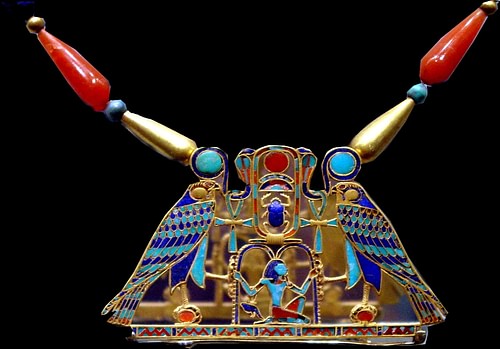
Pectoral of Senusret II
The nigh hit aspect of Middle Kingdom fine art, all the same, is the subject affair. Common people, instead of nobility, feature more than oft in art from this period than whatever other. The influence of the First Intermediate Menstruation continues to be seen in all the fine art from the Heart Kingdom, where laborers, farmers, dancers, singers, and domestic life receive almost as much attending equally kings, nobles, and the gods. Artwork in tombs continued to reflect the traditional view of the afterlife, just literature from the time questioned the old belief and suggested that one should concentrate on the just life one could be sure of, the present.
This emphasis on life on earth is reflected in less idealistic and more realistic artwork. Kings similar Senusret III (c. 1878-1860 BCE) are depicted in statuary and art as they really were instead of every bit ideal kings. Scholars recognize this by the uniformity and detail of the representations. Senusret III is seen in different works at different ages, sometimes looking careworn, sometimes victorious, whereas kings of earlier eras were always shown at the aforementioned age (young) and in the same way (powerful). Egyptian art is famously expressionless considering the Egyptians recognized that emotions are fleeting and ane would non desire one's eternal paradigm to reverberate only one moment in life but the totality of 1's existence.
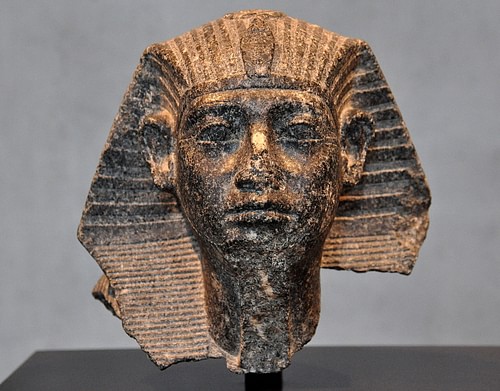
Head of Senusret III
The Eye Kingdom began to dissolve during the 13th Dynasty when the rulers had grown also comfy and neglected the affairs of state. The Nubians encroached from the south while a strange people, the Hyksos, gained a substantial foothold in the Delta region of the due north. The government at Thebes lost control of big sections of the Delta to the Hyksos and could do nothing about the growing power of the Nubians; it became increasingly obsolete and ushered in the era known every bit the Second Intermediate Menstruum (c. 1782 - c. 1570 BCE). During this time the government at Thebes connected to commission artwork but on a smaller scale while the Hyksos either appropriated earlier works for their temples or commissioned for grander works.
Second Intermediate Menstruum/New Kingdom Art
The art of the Second Intermediate Period of Egypt continued the traditions of the Middle Kingdom just often less effectively. The best artists were available to the nobility at Thebes and produced high-quality work, but not-royal artists were less skilled. This era, like the starting time, is too often characterized equally disorganized and chaotic, and the artwork held upwardly as proof, but in that location were many fine works created during this time; they were but on a smaller scale.
Tomb paintings, statuary, temple reliefs, pectorals, headdresses, and other jewelry of loftier quality continued to be produced and the Hyksos, though often vilified by subsequently Egyptian writers, contributed to cultural development. They copied and preserved many of the written works of earlier history which are still extant and also copied bronze and other artworks.
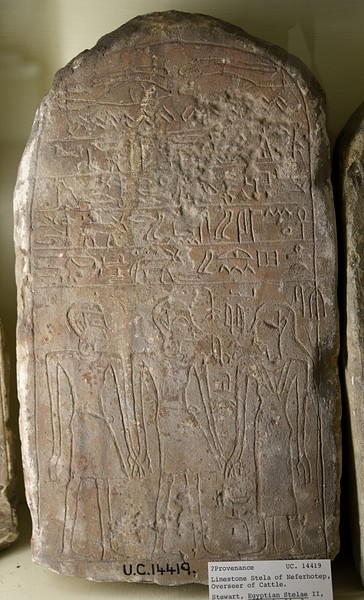
Egyptian Stela of Neferhotep
The Hyksos were finally driven out by the Theban prince Ahmose I (c. 1570-1544 BCE) whose rule begins the period of the New Kingdom of Egypt (c. 1570 - c. 1069 BCE). The New Kingdom is the most famous era of Egyptian history with the all-time-known rulers and most recognizable artwork. The colossal statues which were initiated in the Center Kingdom became more than mutual during this time, the temple of Karnak with its great Hypostyle Hall was expanded regularly, the Egyptian Book of the Expressionless was copied with accompanying illustrations for more and more people, and funerary objects like shabti dolls were of higher quality.
Egypt of the New Kingdom is the Egypt of empire. Every bit the borders of the country expanded, Egyptian artists were introduced to different styles and techniques which improved their skills. The metalwork of the Hittites which the Egyptians made use of in weaponry also influenced art. The wealth of the state was reflected in the enormity of private artworks as well as their quality. The pharaoh Amenhotep III (1386-1353 BCE) built so many monuments and temples that later scholars attributed to him an exceptionally long reign. Among his greatest works are the Colossi of Memnon, two enormous statues of the seated king ascent 60 ft (18 k) loftier and weighing 720 tons each. When they were built they stood at the entrance to Amenhotep Iii's mortuary temple, which is now gone.
Amenhotep Three's son, Amenhotep IV, is meliorate known every bit Akhenaten (1353-1336 BCE), the name he chose later devoting himself to the god Aten and abolishing the ancient religious traditions of the country. During this time (known every bit the Amarna Menstruum) art returned to the realism of the Middle Kingdom. From the kickoff of the New Kingdom, artistic representations had again moved toward the ideal. During the reign of Queen Hatshepsut (1479-1458 BCE), although the queen is depicted realistically, about portraits of nobility show the idealism of Erstwhile Kingdom sensibilities with middle-shaped faces and smiles. The art of the Amarna flow is so realistic that modernistic-day scholars accept been able to reasonably suggest what concrete ailments people in the pictures probably suffered from.
Two of the most famous works of Egyptian art come up from this time: the bust of Nefertiti and the golden death mask of Tutankhamun. Nefertiti (c. 1370-1336 BCE) was Akhenaten's wife and her bust, discovered at Amarna in 1912 CE past the German archaeologist Borchardt is nigh synonymous with Egypt today. Tutankhamun (c.1336-1327 BCE) was Akhenaten's son (but non Nefertiti'southward) who was in the process of dismantling his father's religious reforms and returning Egypt to traditional beliefs when he died before the historic period of twenty. He is best known for his famous tomb, discovered in 1922 CE, and the vast number of artifacts it contained.
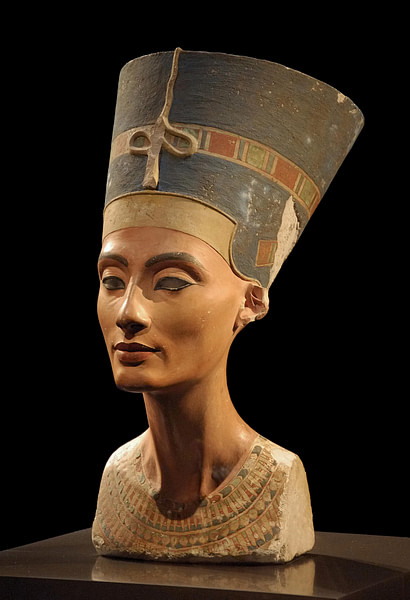
Queen Nefertiti
The golden mask and other metallic objects found in the tomb were all the result of innovations in metalwork learned from the Hittites. The fine art of the Egyptian Empire is amongst the greatest of the civilization because of the Egyptian'southward interest in learning new techniques and styles and incorporating them. Prior to the inflow of the Hyksos in Egypt, Egyptians thought of other nations equally barbaric and uncivilized and did not consider them worthy of any special attention. The Hyksos 'invasion' forced the people of Egypt to recognize the contributions of others and make use of them.
Later Periods & Legacy
The skills acquired would keep through the Tertiary Intermediate Period of Egypt (c. 1069-525 BCE) and Late Menses (525-332 BCE), which are also negatively compared with the grander eras of a strong central regime. The style of these afterward periods was affected by the times and the limited resources, but the art is notwithstanding of considerable quality. Egyptologist David P. Silverman notes how "the art of this era reflects the opposing forces of tradition and change" (222). The Kushite rulers of the Late Menstruation of Aboriginal Egypt revived Quondam Kingdom art in an try to identify themselves with Egypt'due south oldest traditions while native Egyptian rulers and nobility sought to advance artistic representation from the New Kingdom.
This same paradigm holds with Persian influence following their invasion of 525 BCE. The Persians also had keen respect for Egyptian culture and history and identified themselves with Old Kingdom art and compages. The Ptolemaic Period (323-30 BCE) blended Egyptian with Greek art to create statuary like that of the god Serapis - himself a combination of Greek and Egyptian gods - and the art of the Roman Egypt (30 BCE - 646 CE) followed this same model. Romans would draw on the older Egyptian themes and techniques in adapting Egyptian gods to Roman understanding. Tomb paintings from this time are distinctly Roman but follow the precepts begun in the Quondam Kingdom.
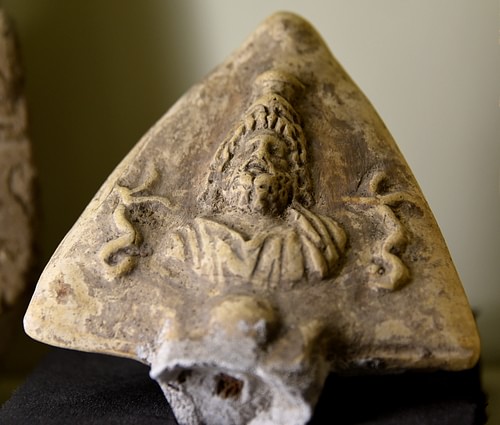
Egyptian Oil Lamp with Serapis
The art of these later cultures would come to influence European understanding, technique, and style which would be adhered to for over 1,000 years until artists in the late 19th century CE, such as the Futurists of Italy, began breaking with the by. Then-chosen Modern Art in the early 20th century CE was an endeavour to force an audition to encounter traditional subjects in a new light. Artists like Picasso and Duchamp were interested in forcing people to recognize their preconceptions about art and, by extension, life in creating unexpected and unprecedented compositions which broke from the past in way and technique. Their works and those of others were only possible, nevertheless, because of the paradigm created past the ancient Egyptians.
This article has been reviewed for accuracy, reliability and adherence to academic standards prior to publication.
Source: https://www.worldhistory.org/article/1077/a-brief-history-of-egyptian-art/
0 Response to "This Is Ancient Egyptian Art Made Around the Time of the Pyramids at Giza Its Date Should Be"
Post a Comment